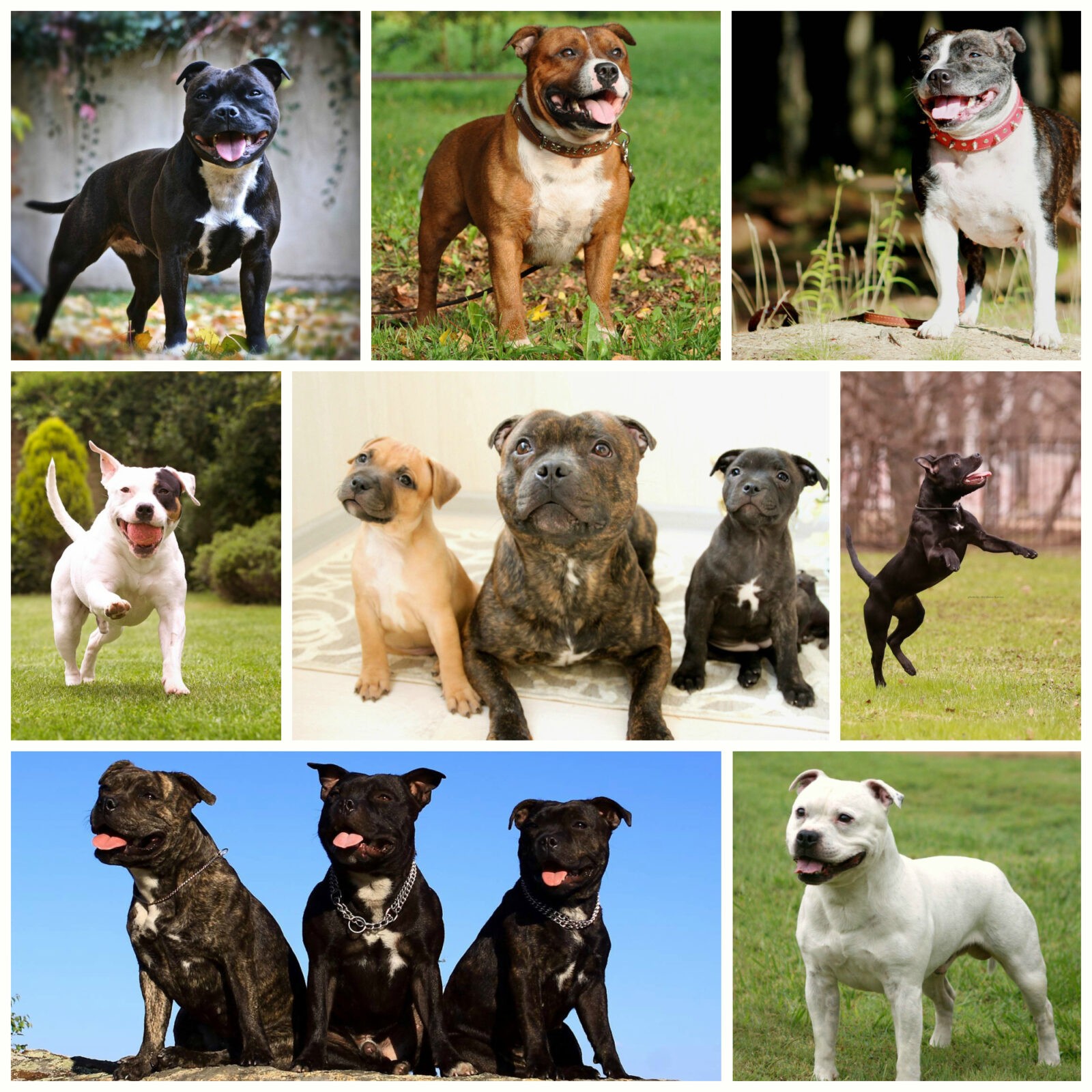Стаффордширский бультерьер — это очень энергичная и подвижная собака средних размеров. Животное имеет укороченную голову, развитые лицевые мышцы и темные глаза, правда, цвет глаз может быть и светлым, в случае светлого окраса шерсти.

Краткое описание породы
Уши могут быть купированы, в таком случае они будут стоять. Если купирование не проводится, то уши наполовину свисают и по форме напоминают розочку. Шея собак этой породы достаточно мускулистая и широкая. Грудная клетка стаффордширского бультерьера также широкая. Внешний вид стаффордширского бультерьера в целом устрашающий, чем с успехом пользуются те, кто хочет защитить себя от посягателей или, к примеру, от грабителей.
Шерсть у представителей этой породы короткая и гладкая, она плотно прилегает к телу. Типичный окрас стаффордширского бультерьера: рыжий, палевый, белый, черный и пепельный. Также окрас может быть комбинированным. Нередко встречаются стаффорды с тигровым или тигрово-белым окрасом. При этом черно-подпалый окрас не считается нормой. Не стоит доверять тем собаководам, которые пытаются продать вам щенка с таким окрасом за более высокую цену, мотивируя это уникальностью щенка. Такая расцветка, по большому счету, является отклонением и может быть следствием генетического заболевания.
Собака была выведена в 19-м веке в Великобритании в качестве бойцовской породы. Но сегодня стаффордширский бультерьер — это прекрасная собака-компаньон, которая славится своим бесстрашием, умом и безграничной любовью к детям.
Внешний вид собаки, особенно ее мускулистое тело и напряженный взгляд, часто производят впечатление жестокого животного. Люди, которые незнакомы с этой породой, позже с удивлением узнают, что стаффорд — это очень воспитанная собака, которая любит играть и веселиться. Для собак этой породы жизнь является неким радостным, увлекательным развлечением.
Огромная армия почитателей этого бультерьера обожает породу из-за своеобразного внешнего вида, а также из-за простоты ухода за шерстью и особенного игривого характера.
Стаффордширский бультерьер по своему внешнему виду напоминает американского стаффордширского терьера и американского питбультерьера. Но эти собаки отличаются между собой целым рядом физиологических особенностей. Именно это и послужило причиной того, что все упомянутые собаки разделены на разные породы.
Стаффорды известны своей любовью к людям и очень доверчивым характером. Главное желание собак этой породы – проводить побольше времени со своей семьей. При этом для собаки неважно, чем заниматься: она может играть и бегать или лежать вместе с вами на диване во время просмотра фильма или футбола. Стаффордширский бультерьер всегда составит вам компанию.
Так как собаки этой породы относятся к очень активным и энергичным, им необходимо реализовывать весь свой потенциал. Помимо этого, стаффордширский бультерьер не любит находиться долгое время в одиночестве.
Довольно часто стаффордов называют собаками-няньками. Это прозвище они заслужили за свое терпении и любовь к детям. При этом ни в коем случае нельзя оставлять малышей с собакой без присмотра взрослых. Следует также отметить, что если в семье есть новорожденные или маленькие детки, то с покупкой щенка этой породы лучше повременить.
Несмотря на замечательный характер и практически безукоризненное поведение, стаффорды не совсем дружелюбны к другим собакам. Содержание собак этой породы запрещено в некоторых странах мира. Всему виной бойцовская история этой собаки, которую так опасаются некоторые муниципалитеты. Но для человека, который понимает своего питомца, готов его воспитывать и обучать, он станет преданным другом.
Основная информация
| Название породы: | Стаффордширский бультерьер |
| Страна происхождения: | Великобритания |
| Время зарождения породы: | XIX век |
| Тип: | терьеры |
| Вес: | 11 – 17 кг |
| Рост (высота в холке): | 35 – 40 см |
| Продолжительность жизни: | 12 – 14 лет |
|
Классификация МКФ:
|
Группа 3, Секция 3, Номер 11 |
| Цена щенков: | 150 – 1250 $ |
| Самые популярные клички: | список кличек для стаффорда |
Оценка характеристик породы стаффордширский бультерьер
| Адаптивность
(определение, означающее, насколько легко собака может приспосабливаться к изменениям в жизни) |
🐶🐶🐶 |
| Уровень линьки
(Уровень и частота выпадения волос у животного) |
🐶🐶🐶 |
| Уровень нежности
(Уровень и количество нежности и ласки, которую собака отдает взамен на внимание к себе) |
🐶🐶🐶🐶🐶 |
| Потребности в упражнениях
(Уровень дневной активности собаки) |
🐶🐶🐶🐶 |
| Социальная потребность
(Необходимое количество контактов собаки с другими животными, а также людьми) |
🐶🐶🐶🐶 |
| Квартирное содержание
(Фактор, определяющий уровень шума и иных неудобств, которые собака может доставлять хозяевам в соотношении размера квартиры к размеру собаки) |
🐶🐶🐶 |
| Груминг
(Количество купаний, расчесываний, а также необходимое количество сеансов профессионального груминга, необходимого собаке) |
🐶 |
| Дружелюбность в незнакомой среде
(Особенности поведения собаки в обществе с незнакомыми людьми или в незнакомой обстановке) |
🐶🐶🐶🐶🐶 |
| Тенденция к лаю
(Склонность к лаю и его частоте и громкости) |
🐶🐶 |
| Вопросы здоровья
(Потенциальный уровень состояния здоровья собаки) |
🐶🐶🐶 |
| Территориальность
(Склонность собаки к защите своего дома, двора или даже автомобиля хозяина) |
🐶🐶🐶 |
| Дружелюбность к котам
(Тенденция к терпимости к кошкам и пониженное проявление охотничьих инстинктов) |
🐶🐶 |
| Интеллект
(Способность собаки к мышлению и решению возникающих трудностей (не стоит путать с обучаемостью!) |
🐶🐶🐶🐶 |
| Воспитание и дрессировка
(Уровень сложности в обучении собаки выполнять определенные действия) |
🐶🐶 |
| Дружелюбность к детям
(Фактор, определяющий насколько собака дружелюбна к детям, любит ли она с ними играть и терпеть некоторые детские шалости) |
🐶🐶 |
| Игровая активность
(Понятие определяется самим его названием, и, как правило, встречается почти у всех собак) |
🐶🐶🐶 |
| Наблюдательность
(Способность собаки определить присутствие чужого на своей территории) |
🐶🐶🐶 |
| Дружелюбность к другим собакам
(Склонность собаки находить общий язык с другими своими сородичами) |
🐶 |
Фото стаффорда:

История происхождения стаффорда
Стаффордширский бультерьер — это порода, чьи истоки берут свое начало в Англии. Порода появилась в те далекие времена, когда на туманном Альбионе была распространена травля быка и медведя. В 1835 году упомянутые виды спорта были запрещены. После этого стаффорд превратился в отличную боевую собаку. Существовавших тогда в Великобритании бульдогов начали скрещивать с черно-подпалыми терьерами, которые очень похожи на манчестерских терьеров. Это делалось для выведения еще лучшей бойцовской собаки. Но в тридцатые годы прошлого века были запрещены и собачьи бои, но подпольно их все еще продолжали проводить (даже сегодня известны случаи проведения боев).
В средине 19-го века Джейс Хинкс из Бирмингема начал программу разведения несколько другого бультерьера. Он скрестил его с практически исчезнувшим тогда английским белым терьером. В результате была получена изящная собака белого окраса. Он назвал ее бультерьером и показывал животное под таким названием до 1860-х годов. Поклонники оригинального старого стиля бультерьера в конечном итоге назвали эту собаку «стаффи-бультерьер». Но такая собака не всех устраивала. Продолжились селекционные мероприятия по совершенствованию породы. Одной из причин совершенствования стала бойцовская история собаки.
Позже был создан клуб, который объединил всех фанатов бультерьера. Английский Кеннел клуб признал эту породу как «стаффордширский бультерьер» для того, чтобы отделить его от белого бультерьера. Произошло это в 1935 году. К концу 20-го века стаффордширский бультерьер вошел в десятку самых популярных пород собак, признанных английским Кеннел клубом. Это было очень важно для развития породы с учетом того, что многие опасались стаффордширского бультерьера из-за его прошлого.
Характер стаффорда
Стаффордширский бультерьер напоминает многих своих собратьев по крови, в том числе американского стаффордширского терьера и питбуля, но эти крепкие собаки выглядят намного жестче, чем они есть на самом деле. Многие владельцы стаффордов единогласно утверждают, что эта собака — не боец, а нежное, ласковое животное.
Стаффорд с удовольствием готов провести целый день, играя с вами или с детьми. Они обожают находиться среди людей. При этом питомцы могут вести себя по разному: резвиться и веселиться или просто провести несколько часов перед телевизором вместе со своим хозяином. Но, конечно же, лучше всего, чтобы питомец проводил время в активном движении. Именно поэтому стаффордширский бультерьер подходит активным людям, у которых достаточно свободного времени.
Несмотря на несколько устрашающий вид и сильное, мускулистое тело, стаффорды превосходно ладят с детьми. Однако тем семьям, у которых совсем маленькие детки, не рекомендуется эта собака. Питомец станет отличным другом и веселым соперником в играх для детей среднего и старшего возраста.
Содержание и уход
Стаффордширский бультерьер склонен к круглогодичной линьке. Правда, она достаточно умеренная, не очень обильная. Регулярное вычесывание поможет поддерживать шерсть в нормальном состоянии. Собаки этой породы не склонны к тому, чтобы издавать неприятные запахи, поэтому купают их по мере необходимости.
Еженедельно нужно проверять уши стаффорда на наличие инфекций или воспалений. Очищают ушные раковины специальным раствором, назначенным ветеринаром. Также каждую неделю необходимо чистить питомцу зубы. Эта процедура предотвратит образование зубного камня и неприятного запаха изо рта. Кроме того, чистка зубов станет гарантией здоровья десен. Когти следует подстригать один раз в месяц.
Дрессировка и обучение стаффорда
Тех стаффордов, которые сразу и беспрекословно пошли на контакт и стали быстро выполнять команды, можно пересчитать на пальцах. Начинающие собаководы обязательно должны проконсультироваться с профессионалами, которые расскажут все нюансы, касающиеся дрессировки cтаффордширского бультерьера.
Опытные же собаководы уже знакомы со всеми проблемами и трудностями, которые могут появиться во время дрессировки. Стаффордширский бультерьер нуждается в опытном и уверенном в себе тренере, который сможет проявить достаточное количество настойчивости. Но не стоит забывать, что настойчивость и жестокость — это совершенно разные вещи!
Здоровье и болезни
Несколько интересных фактов
- Стаффордширского бультерьера нельзя оставлять жить на улице. Собака будет нормально развиваться лишь проживая вместе с семьей.
- Никогда не гуляйте с питомцем без поводка, так как он может проявлять агрессию к другим собакам.
- Стаффорды очень умны, но обладают независимым характером, который может стать серьезной проблемой во время дрессировки.
- Стаффордширский бультерьер — энергичная собака, нуждающаяся в активных занятиях или хотя бы в ежедневных длительных прогулках.
- Собаки этой породы охотно поваляются вместе с хозяином на диване во время просмотра телевизионных передач.
- Стаффорды линяют круглый год. Вам придется еженедельно вычесывать собаку, чтобы поддерживать шерсть в должном состоянии.
- Стаффордширский бультерьер нуждается в ранней социализации, особенно если вы хотите, чтобы питомец был дружелюбен с другими животными.
- Щенки стаффордширского бультерьера любят жевать, особенно в щенячьем возрасте. Заранее побеспокойтесь о специальных игрушках.
- Стаффорды обожают рыть ямы. Побеспокойтесь о том, чтобы ваш двор был забетонирован и надежно огражден.
- Несмотря на то, что представители этой породы могут жить в квартире, все же оптимальный вариант — частный двор с огороженным двором.
- Стаффордширский бультерьер плохо переносит жару. Побеспокойтесь о том, чтобы ваш питомец не перегревался в жаркое время года.
- Эти бультерьеры очень любят детей. Несмотря на это никогда не оставляйте маленьких детей наедине с собакой без присмотра взрослых.
- Если период социализации проведен правильно и в срок, то стаффорд может отлично уживаться с другими животными, даже в одной квартире.
- Стаффордширский бультерьер обладает очень сильным охотничьим инстинктом. Будьте готовы к тому, что ваш питомец может гоняться за другими животными, воспринимая их как добычу.
- Болевой порог у этих собак очень высокий. Именно поэтому стаффорды могут скулить даже от малейшего ушиба.
- Во многих странах мира собаки этой породы запрещены.
- Щенки стаффорда очень активны и общительны. Старайтесь никогда не оставлять их в одиночестве.
- Стаффордширский бультерьер — отличный защитник семьи. При этом с ролью сторожа он вряд ли справится. Главная его задача — защитить своего хозяина и членов семьи.
Питомники и заводчики
Материал мы заимствовали с замечательного сайта наших партнеров DOGCATFAN.COM о кошках и собаках, автор dogcatfan
